This is “Designing”, chapter 9 from the book Writers' Handbook (v. 1.0). For details on it (including licensing), click here.
For more information on the source of this book, or why it is available for free, please see the project's home page. You can browse or download additional books there. To download a .zip file containing this book to use offline, simply click here.
Chapter 9 Designing
The Right Look
Using design options, you can vary the look of your written work. You can make design choices based on your personal preferences, requirements, purpose, and audience. You have many options regarding both text formatting and use of visuals.
9.1 General Text Formatting Considerations
Learning Objectives
- Understand the overall page layout options.
- Recognize fonts that suit your needs.
- Use text features, such as headings and lists, to enhance your work.
Think about a résumé, an event flyer, a page in a research paper, a business letter, and a page in a novel. All these items start out exactly the same—as a blank page. The second step is typically also the same—text is added. The third step, however, differs, as the text formatting is varied to create the desired look. Based on requirements or audience expectations, you will sometimes want to conform to conventions. Other times, you can employ more personal choices. For example, an essay conforming to the American Psychological Association (APA) or Modern Language Association (MLA) style sheet (discussed in Chapter 10 "Publishing") has very rigid requirements regarding font choice, margin size, subhead formatting, and placement of page numbers. Likewise, as discussed in Chapter 12 "Professional Writing", Section 12.1 "Writing Business Letters", a business letter has some audience-expected features, such as date, name and address of person receiving the letter, greeting, introduction, body, closing, salutation, signature, and contact information for the sender of the letter. A business letter, however, does have a bit more flexibility than a paper written in APA style does since you can vary some aspects, such as your font choices and margins. On the other hand, a business letter written in an unusual or silly font will not likely be well received, so you’ll want to make choices with audience expectations in mind.
Choosing Formatting Options
As you begin to design a document, you will need to consider the basic layout, margins, line spacing, and alignment on the page. If none of these options matter to you, you can simply accept the default choices of the software you are using. For most documents, however, you will likely want to make some changes from the default settingsSoftware choices made in the factory and that remain in place until a user chooses to make changes.. You might even want to change your default settings to match the desired format of your most frequently used document type.
Basic Layout
You will need to decide the best basic layout for your document. For example, if you are writing a novel, you will likely want to use straight text in paragraphs. But if you are creating a comparison of three novelists’ treatments of the same topic, you might want to use columns or a chart. If you are creating a flyer, you might prefer strategically placed text boxes (for more on flyers, see Chapter 14 "Public and Personal Writing", Section 14.2 "Creating Flyers and Brochures"). You will make your layout and formatting choices based on set requirements or your personal choices regarding the visual effects you want to convey to your readers.
White Space
White spaceThe area on a paper or screen that is not covered with text or images. is the area on a page (hard-copy or digital) that is not covered with text or images. Keep in mind that well-used white space makes a page more visually appealing and easier to read. White space, of course, is not always white; on a blue sheet of paper, or against a blue backdrop on a web page, white space is blue. Regardless of color, a balance of white space and text makes a page easier and more inviting to read.
When you are free to make your white-space choices, use white space to set headings and subheadings off from the main text. Use either 1½ or double spacing for the text body to provide a little white space between the lines of text, and use one-inch margins all around. Using columns is another way to create white space. Columns allow you to place considerable amounts of text on a page without creating an overwhelming appearance.
Margins, Line Spacing, and Indents
You can also set margins and line spacing to manage the amount of white space in a document. In some situations, such as a specific academic research or professional setting, you are likely to encounter specific guidelines regarding margin widths and line spacing. In many situations, however, you will be able to choose your margins and spacing. Apply logic as you make these choices so that your document can function to your best advantage. For example, if you or someone else will need space to add notes or edits, use double or triple spacing and wide margins. On the other hand, if you need the text to fit within a tight spot, tighten both the margins and line spacing. Keep in mind that the tighter the text is, the less inviting it is to read. Indenting is another option when making basic layout plans. Again, some situations require it and others leave it up to your discretion.
Alignment on Page
Alignment choices can also affect the overall look of a page of text. With most word processing software, you can choose to align text to the left, to the rightText where all lines end on the same imaginary vertical line on the right side of the paper., or to the centerText where all lines are centered from left to right.. You can also justifyText where all lines begin on the same imaginary vertical line on the left side of the paper and end on the same imaginary vertical line on the right side of the paper. text, which is sort of a combination of the other three options:
Figure 9.1
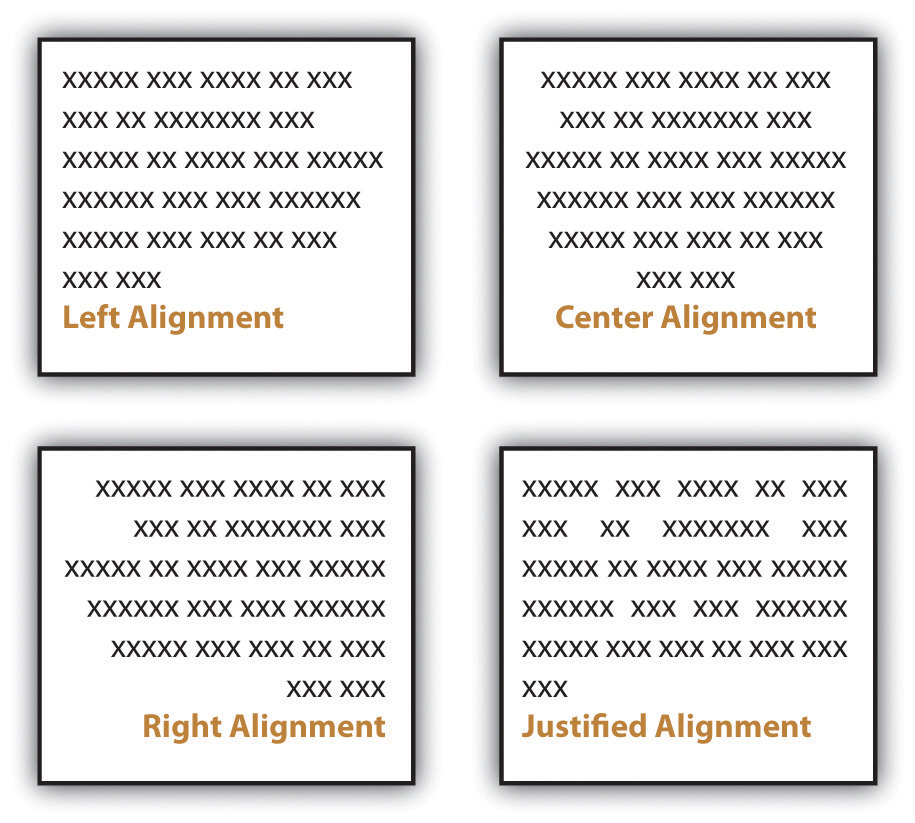
Most business and academic documents use left alignmentText where all lines begin on the same imaginary vertical line on the left side of the paper. as the standard format. The other three options are used less often but can provide effective alternatives in specific situations. For example, you will usually center-align text on a title page; you will typically right-align the page numbers in a table of contents, and you might justify text when you want to fit the maximum amount of text within the given space (such as within a newspaper article). Both center-aligned text and right-aligned text should be used sparingly since they are difficult to read in large amounts.
Appendices
Detailed information that would interrupt the flow of your document is better placed in an appendix than in the flow of your text. Using appendices makes it easier for readers to read your text, and they set apart details that some readers might not want to read or might want to read independently from the main body of text. If you have one item to place in an appendix, title it “Appendix,” and refer to it as such in the text. If you have more than one document to place in appendices, label them “Appendix A,” “Appendix B,” and so on. As with images, always refer to the appendices at the relevant point in the text, but do not repeat the bulk of the content within the text. The following are examples of information typically relegated to an appendix:
- Budget/cost figures
- Consent forms
- Full-page images
- Institutional Research Board (IRB) approval
- Large tables
- Letters
- Long lists
- Questionnaires
Using Text Features
Along with basic layout choices, you can control the look and feel of a document using certain text features. As with the other formatting options, you should base your choices based on your personal preferences, requirements, and audience expectations.
Headings and Subheadings
You can use headings and subheadings to break up text to make it easier to read. Keep two points in mind when you are deciding whether to use headings and subheadings: consistency and organization. Your headings should follow a consistent pattern in regards to both parallelism and content hierarchy, and the headings should help the readers see the relationships between parts of the text.
Figure 9.2
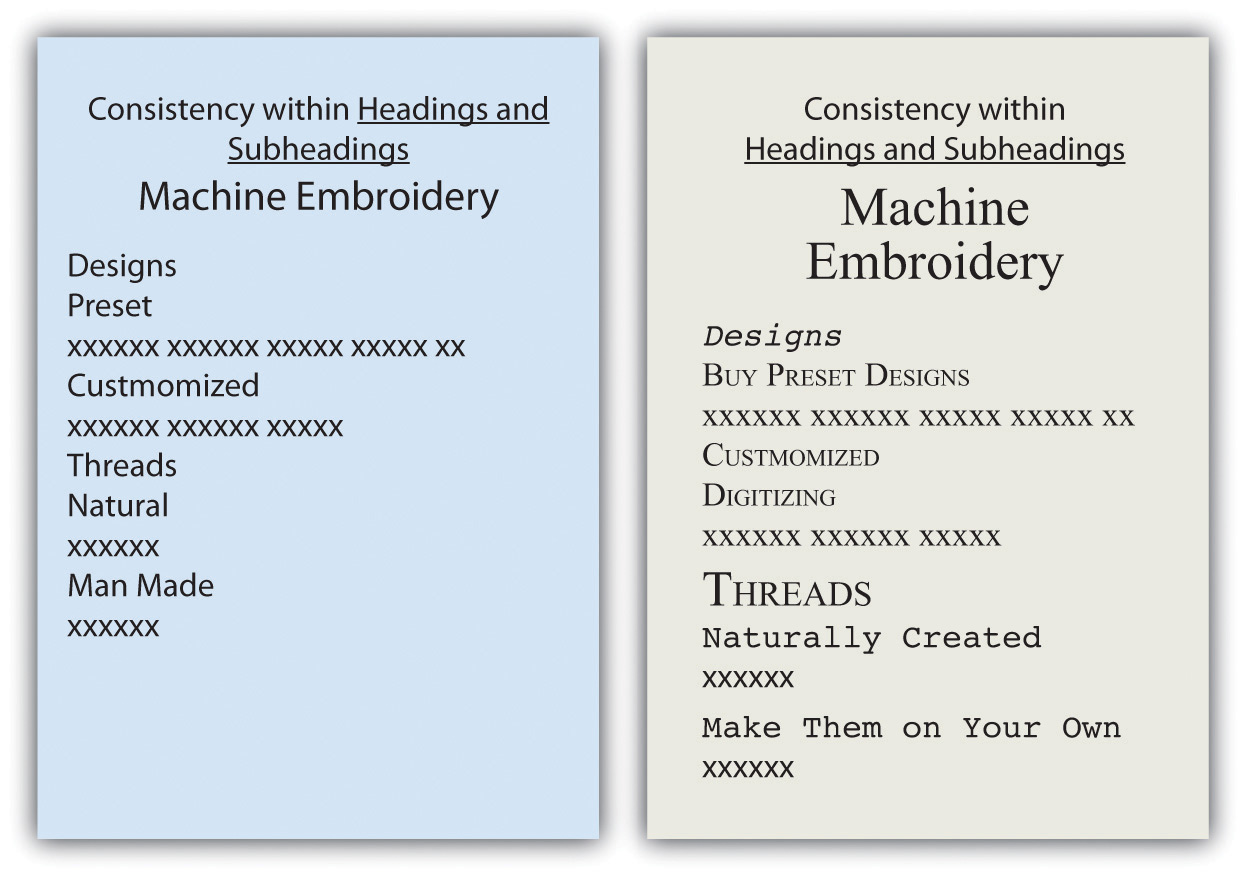
Headings and subheadings also provide a means of organizing text into categories that help readers comprehend the relationship between parts of the text both during a thorough read and when quickly glancing over the text. Clearly, headings and subheadings are not appropriate in some situations, such as within business letters and in documents that are only a couple of paragraphs long.
Take efforts to create short, informative headings and subheadings. Within a document, maintain consistency for headings and subheadings. For example, you might choose to make all the main headings gerund phrases (e.g., Using Text Features) and all the subheadings questions (e.g., Will Visual Text Features Help?). Also, use the same font features for each level of heading to create consistency. In some situations, your heading format is preset. Other times, you have choices. In both situations, you should maintain parallel format across each level.
Fonts
Today’s word processors typically offer a wide variety of font choices. You should choose a font that meets your needs. For example, a research paper might require the use of the Times New Roman font for ease of reading, an invitation might look best in a swirly script for fanciness, and a poster often demands a dark, heavy font for distance viewing. Two common fonts that are widely used in professional and academia settings are Times New Roman and Arial.
Figure 9.3
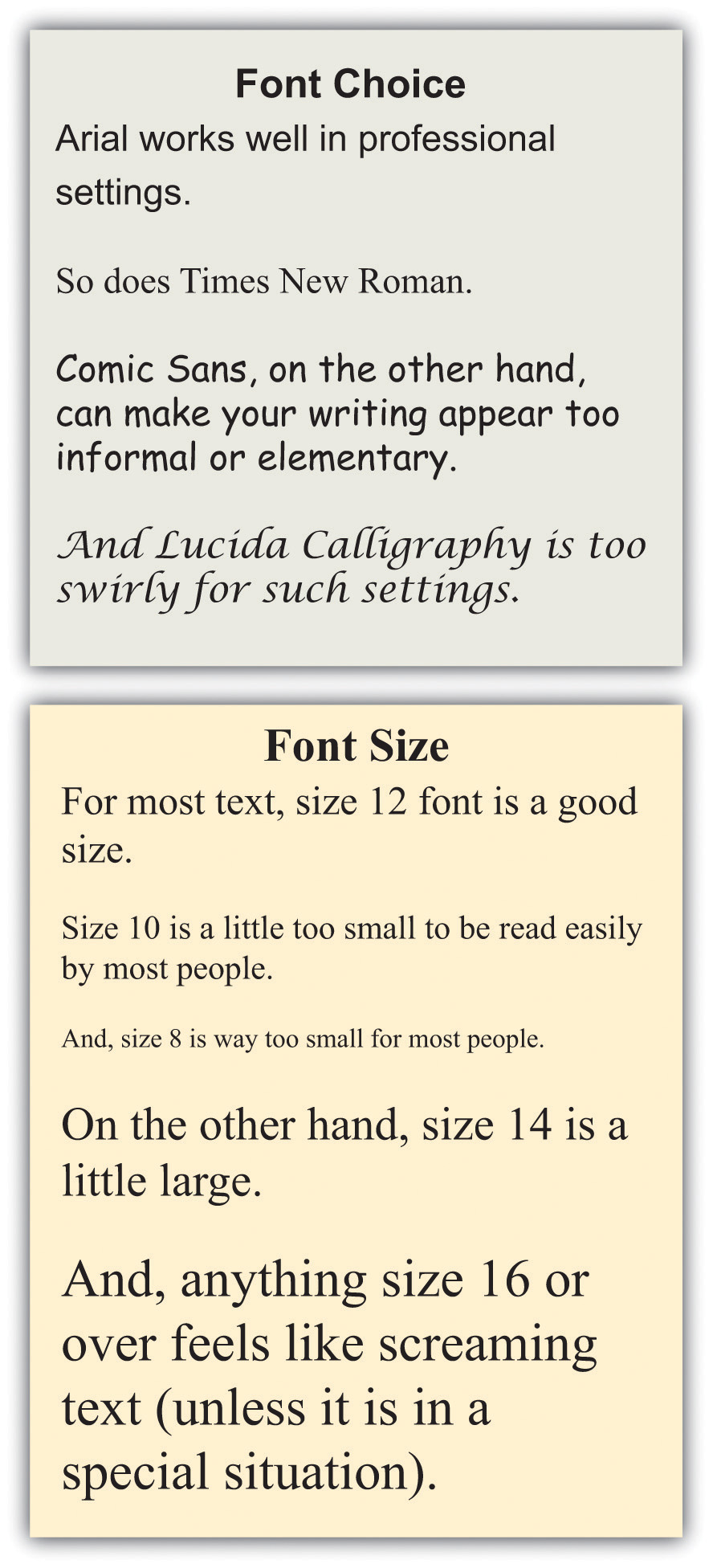
Typically, you should use 12-point font for standard text. Headings might be a size or two larger. In the absence of required sizes, you should use standard sizes to make your text easy to read.
Other Text Features
Along with font choices and sizes, you can also enhance your text using visual text features, such as those that follow. You can use the features in many ways, such as to call attention to text, to set text apart, and to make text easier to read at a glance.
- Bolding
- Italicizing
- Underlining
- Shading
- All caps
- Small caps
- Color
- Lists (such as this one)
As a rule, you should use these features sparingly so you do not diminish their effects. Exceptions to this general rule are some of the features that have specific, set uses. For example, standard format requires that you write acronyms in all caps and titles of books in italics.
Achieving a Clean Look
Although you do want to take steps to break up the text on a page, you do not want your pages to look cluttered. To create a clean look, keep your features to a minimum.
- Use only one or two images on a page. Although images help the readabilityEase with which text can be read and understood. of a page, a page needs a balance of text and images.
- Use only one or two lists per page. Although lists help make a page look clean, too many lists makes a page look like one big list.
- Use headings only for broad topics and subtopics. A page with too many subheadings looks cluttered and choppy.
- Use a maximum of three different fonts per page, but try to use only one or two.
- Use standard fonts, such as Arial or Times New Roman, for your text. Swirly, fancy fonts are hard to read in large amounts and will make your text look cluttered.
- Use comfortable font sizes, such as 10- or 12-point font for text body, 14-point font for subheadings, and between 20- and 24-point font for titles. Using fonts that are too large makes your text “scream,” and using fonts that are too small makes your text unappealing.
Key Takeaways
- Written assignments in academic and professional settings are both likely to have set requirements. If you do not have specific requirements, choose formats that fit your need, such as columns, paragraphs, or strategically placed text boxes. Set your margins, line spacing, and indents to suit your needs. Decide whether you want your text left aligned, centered, right aligned, or justified.
- You can control the look and feel of your written work by consistently using headings and subheadings and choosing fonts and font sizes carefully.
- You can create interesting effects in your text by using visual text features, such as bolding, italicizing, underlining, all caps, small caps, color, and lists.
Exercises
- Create a flyer to advertise a product that you want to promote. (The product can be fictional or actual.) On a separate page, explain your choices of basic layout, margins, line spacing, indents, alignment, subheadings and headings, font choice, font size, and at least three visual text features. (See Chapter 14 "Public and Personal Writing", Section 14.2 "Creating Flyers and Brochures" for more guidance on designing flyers.)
- Find five very different examples of text either in hard copy or online. If you find something online, print out the page. Create a table showing how the five samples are alike and different based on basic layout, margins, line spacing, indents, alignment, subheadings and headings, font choice, font size, and visual text features.
- Make a list of ten different reasons you might create text. List the five reasons at the top of a ten-column page. Down the side of the table, write basic layout, margins, line spacing, indents, alignment, subheadings and headings, font choice, font size, and visual text features. Fill in the table showing some logical choices for each type of writing.
9.2 Creating and Finding Visuals
Learning Objectives
- Learn to be a critical consumer and producer of visual images to meet your needs.
- Understand the proper ways to use images created by others.
It may be a cliché to say “a picture is worth a thousand words,” but the truth is that visual images have power. Types of visuals include the following:
- Photos
- Tables
- Charts
- Line graphs
- Pie charts
- Flow charts
- Concept clarification diagrams
- Stock photos
Incorporating lists, tables, and images is another way to break up daunting blocks of text with a combination of text-breaking images and white space. You can add white space by presenting your lists vertically rather than running them horizontally across the page as part of a sentence. Also, you can leave enough white space around images to frame the images and separate them from the text.
Besides white space, there are other considerations to keep in mind when choosing visuals. When possible, use a variety of types of visuals, but remember that any visuals you use should enhance the content of the text. For example, only add photos if viewing the photos will clarify the text. Near each visual, explain its purpose. Do not expect your readers to figure out the values of the visuals on their own. However, when you explain the purpose, do not explain it so thoroughly that readers have no reason to look at the visuals. For example, you should either list out the types of visuals or use a diagram such as the one shown and say “Use a variety of visuals, such as those shown in the box at right.” Do not both list out the options in your text and show them visually in a textbox.
You have three basic choices for finding visuals to use in your work. You can search the Internet, use photos you have taken, or create images by hand or on the computer.
The Internet is a powerful tool that you can use in several ways to find visuals to complement your work. If you simply click on “images” for your topic in a search engine, you will generate both royalty-free and protected images. However, if you include a term such as “stock imagesImage for sale from an image-source company.,” “stock photosPhoto for sale from a photo-source company.,” or “royalty-free imagesImage that is available for free use.” along with your topic, you will be able to narrow your search to royalty-free items. For example, if you are writing on the topic of the effect of television on children, you might search for “television children stock images.” Such a search will generate many options that could support a claim about the mesmerizing effect of television on children or the lack of physical activity involved in watching television.
Figure 9.4

© Thinkstock
Many services provide photos for use in publications. In these situations, you have to pay for the use of the photos and cite your source. Any pictures you take yourself are clearly royalty-free for your use. Taking a clear, meaningful picture that would be appropriate for use in your work is possible. For example, if you have children of your own or have friends or relatives who have small children, you could easily find an opportunity to take a photo such as Figure 9.4. To avoid rights issues, ask any human subjects included to sign a waiver giving you permission to use their likenesses. In the case of minors, you would obviously need to ask their guardians to sign the permission form.
Here’s an example of a typical waiver:
Permission Form for Use of Human Likeness
I give Joe Student permission to use my likeness [or the likeness of _______ for whom I have guardian or parental responsibility] in his paper entitled “Paper Title.” I understand that this paper could possibly appear in print or digital form as part of educational knowledge or research.
Signature___________________________ Date___________________________
Similarly, pictures taken by friends or relatives could be available for your use as long as you get signed permission to use the photo as well as signed permission from any human subjects in the photo. Although it might seem silly to ask your sister, for example, to give you signed permission to use her photo or image, you never know what complications you could encounter later on. So always protect yourself with permissions.
A third option is to create your visuals. You do not have to be an artist to successfully choose this option. You can use computer programs to generate very professional looking charts, graphs, tables, flow charts, and schematic images. The following examples show just a fraction of your options when using standard word processing software programs.
Figure 9.5
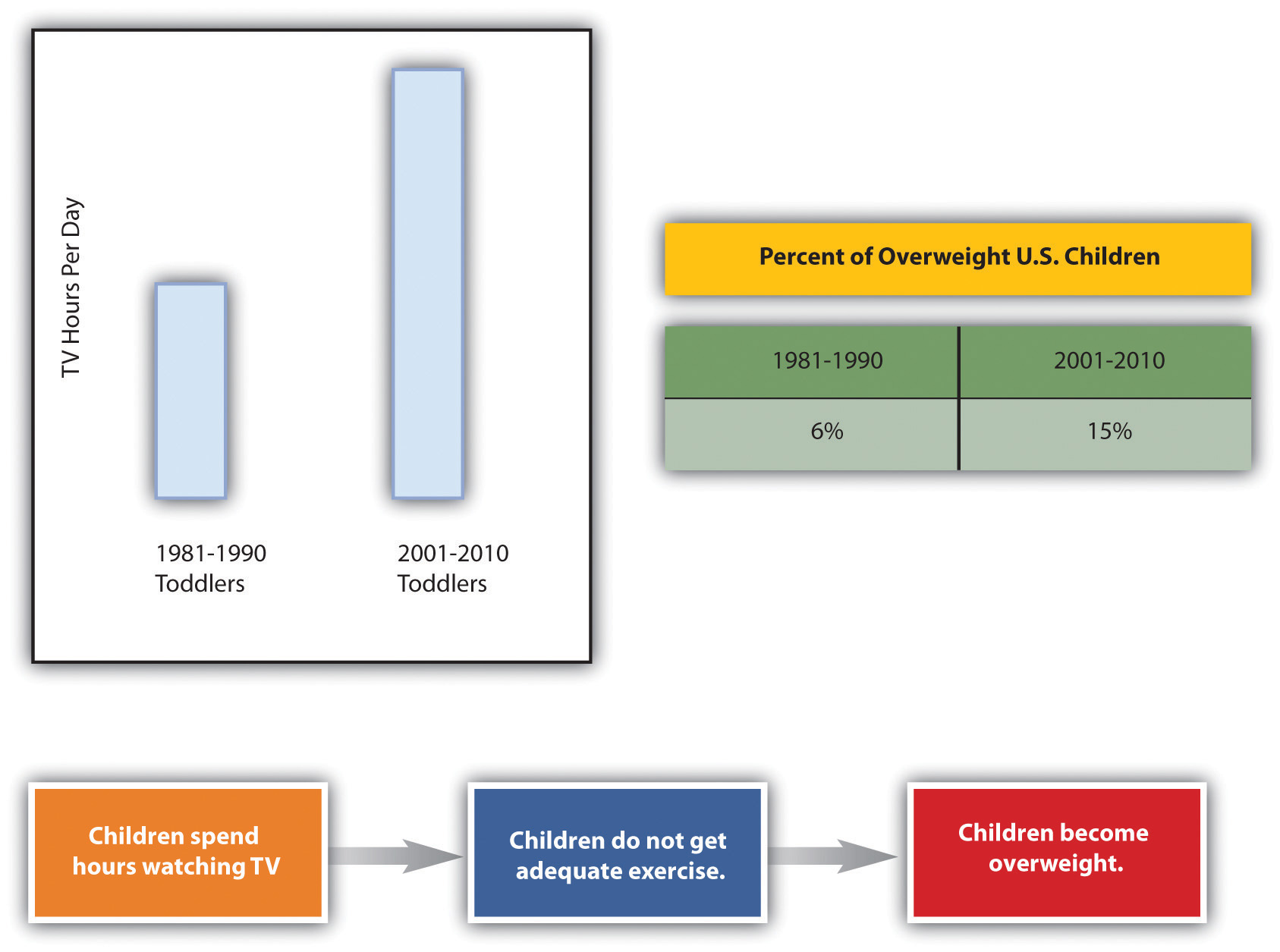
When you create graphics, make sure to group the components. If you find that your graphics are not holding together when viewed on other computers or in other programs, save each graphic in a separate JPEG file and use the JPEGs in your paper.
Since you will most likely submit your work in a digital format, you will probably not have to be concerned with the quality of photos you choose to use. On the other hand, if you do have to submit a paper in hard copy and are incorporating photos, make sure to use a printer with photo-quality capabilities.
Subject your visuals to the same level of scrutiny as your writing. Keep in mind that if you find one person who has a problem with one of your visuals, there will be others who also take exception. On the other hand, remember that you can never please everyone, so you will have to use your judgment.
Consider all your options as you choose whether to find existing visuals, take photos, or create visuals or a combination of the three possibilities. There is no right choice as long as the images you choose add value to your work.
Key Takeaways
- You can satisfy your need for images in your work by purchasing photos or images, taking photos, or creating images.
- You can freely use images you create or pictures that you take with a camera. If you choose to use images created by others or pictures taken by others, you should either secure permission or cite your source.
- If you create your images, make sure they are in a format that will work well, such as a JPEG.
Exercises
- Search online and then choose a source of professional images. Explain the process and cost for using the images.
- Write a two-page paper on a topic of your choosing. Insert at least three photos you have taken into the paper.
- Using word processing software, create an image, such as a flow chart or graph, on a topic of your choice. Save your completed image as a JPEG.
9.3 Incorporating Images, Charts, and Graphs
Learning Objectives
- Know how to insert images into a body of text.
- Understand the role of visual rhetoric in argument and other genres of communication.
- Be aware of standard guidelines for choosing images.
Charts and graphs have long been part of research papers. With the growth of computer capabilities that can capture the world visually, research papers today typically include more charts, graphs, and images than those produced in previous years.
Physically Placing Images into Text
When you insert an image into your text, you must make some physical decisions. One of the most common choices is to place the image to the right or left of your text.
Figure 9.6
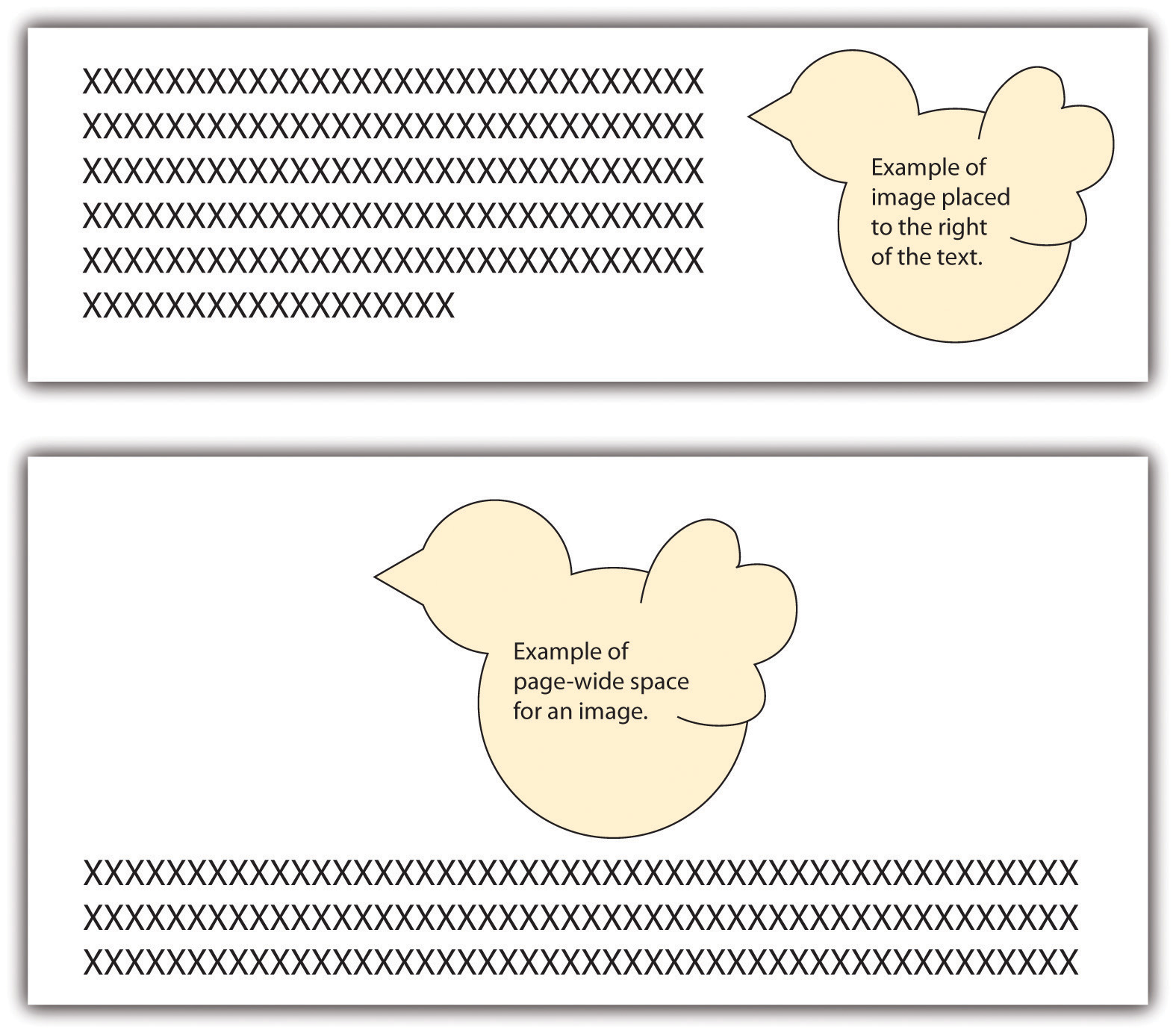
Another choice is to move the text down to create page-wide space for the image. In such situations, the image is typically placed above the related text. This format is usually used at the beginning of a document where the image treatment doesn’t break up the text.
Uses and Abuses of Visual Rhetoric
You should choose visuals to advance your argument rather than just to decorate your pages. Just as you would not include words that are fluff, you should not include meaningless images.
Also, just as you aim to avoid the use of fallacies in your text, you also need to be careful not to use fallacious visuals. (See Chapter 4 "Joining the Conversation", Section 4.3 "Rhetoric and Argumentation" for more on fallacies.) For example, if you were arguing for or against the proposition that big dogs make good pets for families, you might show a picture of a Rottweiler. Figure 9.7 shows how the “for” side could choose a docile example (Rottweiler A), while the “against” side could choose a ferocious example (Rottweiler B) in order to support their respective claims.
Thanks to common programs such as Photoshop, you can easily alter a photo, but make sure to do so ethically. For example, say that you are making an argument that the Moser Company unfairly hires only young people and disposes of employees as they age. You decide to show a photo of some of the employees to make your point. You crop the original photo in Figure 9.7 (Moser Company A) into the version shown as Moser Company B. This cropping choice would be an example of a faked, misleading photo and would be unethical.
More than likely, you have seen tables or graphs that paint a reality that is not exactly accurate. For example, the two graphs in Figure 9.7 could be used as proof that “twice as many” high school teachers as grade school teachers choose to use computer-driven whiteboards. Graph A seems to support this statement nicely. If you look at Graph B, however, you realize that the entire sample includes only three teachers, so “twice as many” means, literally, two out of three—an inadequate sample that leads to neither impressive nor convincing data. Be very careful not to misrepresent data using tables and graphs, whether knowingly or accidentally.
Figure 9.7

Photos © Thinkstock
Weighing Your Options for Visuals
Visuals, like oral or written text, can make ethical, logical, and emotional appeals. (See Chapter 4 "Joining the Conversation", Section 4.2 "Recognizing the Rhetorical Situation" for more on rhetorical appeals.) Two examples of ethical appeals are a respected logo and a photo of the author in professional dress. Graphs, charts, and tables are examples of logical appeals. For the most part, nearly all visuals, because they quickly catch a reader’s eye, operate on an emotional level—even those that are designed to make ethical and logical appeals.
Consider the following options as you choose visuals for your work:
- Choose visuals that your audience will understand and appreciate. Besides adding information, visuals can help you establish common ground with your audience.
- Think about the possible emotional reactions to your visuals and decide if you they are reactions you want to evoke.
- Make sure you choose ethically when using images to make an ethical appeal. For example, it is unacceptable to use an agency for credibility if you do not have the access rights, or the suggested connection is not real.
- Make sure you present the information accurately and in a balanced way when using images such as charts and tables to create a logical appeal.
- Look for visuals that are royalty-free or create your own, unless you are prepared to pay for visuals.
- Spend some time browsing through possible visuals in hopes of seeing something that makes a claim that works with your argument if you do not know what claim you are trying to make with a visual. (A caveat: You can fritter away a lot of time looking for visuals, so don’t browse for visuals at the expense of reading and writing.)
- Make sure you choose visuals that align with the ethical standards of your work, because visuals can sway readers quickly. If your text is solidly ethical, but your picture(s) are inflammatory, you might compromise the ethics of your whole work.
- Keep captions brief if you need to use them. Some images carry meaning without any explanation. If you can’t keep the caption brief, you probably need a different visual or better context for the visual in the text of your essay.
Key Takeaways
- When inserting images, you can wrap text to provide rectangle white space, tightly fitting white space, or paper-width white space.
- Visual elements of communication are especially powerful rhetorical tools that can easily be abused but can also be used responsibly and effectively.
- Commercial (or political) messages presented visually can easily mislead consumers (or voters), but it is much more difficult to take advantage of someone who knows how visual rhetoric works.
Exercises
- Create one page of text. Insert an image to the right of the text, one to the left, and one across the width of the page.
- Collect ten websites and advertisements. Examine each for use of visual rhetoric. Identify any instances where the websites and ads have used visual appeals unethically.
-
Write a journal or blog entry or a short essay that addresses some or all the following questions:
- How do you present yourself visually to others on social networking sites like Facebook?
- What kind of profile picture did you choose, and how did you decide on it?
- How often do you change your profile picture and why?
- How do friends of yours present themselves to the world through such sites?
- What would you say are the main types (or genres) of social networking site profile pictures?
- What are the messages each genre is trying to convey?




